Geography of Nepal: Important Geographical Information about Nepal
In this Country Profile
Nepal is a beautiful landlocked country with the north side bounded by the Xizang Autonomous Region or Tibet and the Himalayan mountain range, while the east, west and south are bordered by India. Its rectangular shape, around 200 km wide and 650 km long is just a bit larger than Arkansas and Bangladesh. As such, Nepal largely relies on India for access out of country to reach the Bay of Bengal, which is also where the goods from China are transported.
Nepal is divided into three regions, the Tarai plains on the southern section from the Indian border and going inward to the hill and mountain regions, with each region going higher in elevation toward the Himalayan border. All regions are parallel across the length of Nepal from east to west, making a continuous ecological belt, with some parts divided by Nepal’s river systems. The division was made by the Nepali government to assist in regional planning for development, as there are ecological variations and different weather conditions within each region that greatly affects the sources of livelihood of the population.
Mountain Region
The Parbat or the mountain region is located over 4,000 meters above sea level, situated to the northern side of the hill region. The mountain region comprises the central section of the Himalayan mountain range where Mount Everest is located as well as some of the highest (over 8,000 meters) peaks in the world. According to local legends, this is the area where the Yeti (abominable snowman) lived. The section that is about 5,000 to 5,500 meters high is where the snow line begins and where extreme climatic and topographic conditions occur. The mountain region is thinly populated because living in the area is arduous and not economically viable. Farming activities are confined to river basins and low valleys. There was trading and animal raising and herding around the 1990s and the traders migrated between the lowlands and the highlands in a seasonal cycle to sell their goods and buy commodities. Most dwellers in this region became guides for trekkers and mountain climbers.
Hill Region
To the southern side of the mountain region is the second division, hill region or pahar. The altitude of the region is between 1,000 to 4,000 meters. This is where the valley of Kathmandu, the richest and highly urbanized section of Nepal is located. The valley is still mountainous with the Siwalik or Churia Range and the Mahabharat Lekh occupying it, with several valleys in between. Despite the valleys, the land is not ideally suited for agriculture due to isolation and the rocky landscape but the region thrived as a cultural and political center, due to migration from India and Tibet. Geologic forces and intervention by people living in the area created a complex series of terraces on the lower hills and farmers adapted to the sparse landscape and seasonality by planting crops whenever they can and engaging in animal husbandry, which is more suitable to the land. Seasonally, rice, millet, barley, maize and potatoes are grown.
Tarai Region
This region is situated in the lowland where humid and sub-humid conditions exist. The section is parallel to the hilly region and stretches along the India-Nepal border. The northern part rises 300 meters above sea level while the section at the base of the Siwalik Range has an elevation of about 1,000 meters. The valleys are richer and multiple crops can be planted here. Notable are the Rapti or Chitwan valley in the center of and the Surkhet and Dang valleys in the west.
Tarai is derived from a Persian word which means damp. Basically the tarai region is wetland, where the climate is hot and humid. This region is irrigated by the Karnali and Kosi rivers of Nepal and the Narayani which is part of the Gandak River from India and several tributaries. The tarai region is the richest region in Nepal because the land is suitable for agriculture and there where forests around that became sources of timber and other forest products.
Climate
Nepal falls under five climatic zones, identified by Sharad Singh Negi, a scholar who conducted a study on the climactic conditions of Nepal according to altitude. The low-lying areas that have an elevation of about 600 to 1,200 meters are in the tropical and sub-tropical zone. Areas that are about 1,200 to less than 2,500 meters above sea level fall under the temperate zone. The cold zone prevails in areas that are from 2,400 to over 3,500 meters high; sub-arctic climate is felt to the sections that have an altitude of up to 4,000 meters. Beyond that is the arctic zone. These climatic zones greatly affect the botanical and the precipitation patterns which have great impact on agriculture and the nation’s food supply.
:: References ::
http://countrystudies.us/nepal/21.htm
http://en.wikipedia.org/wiki/Geography_of_Nepal

Sorry, the comment form is closed at this time.